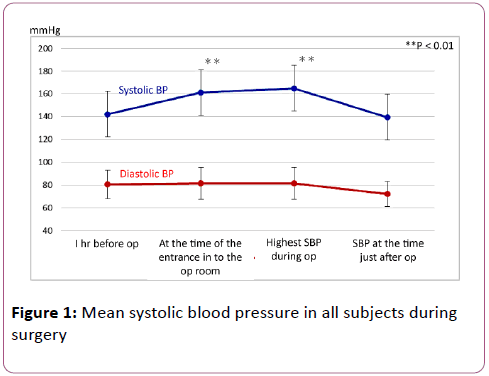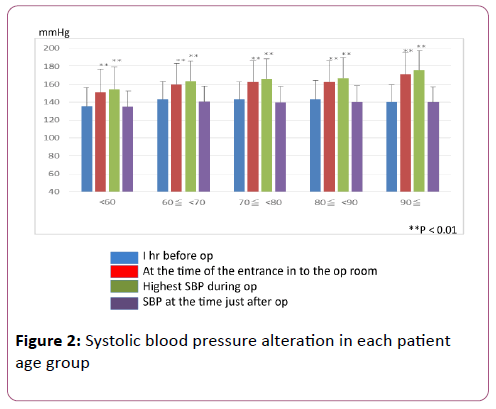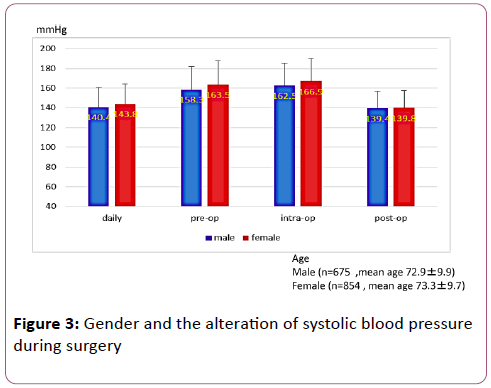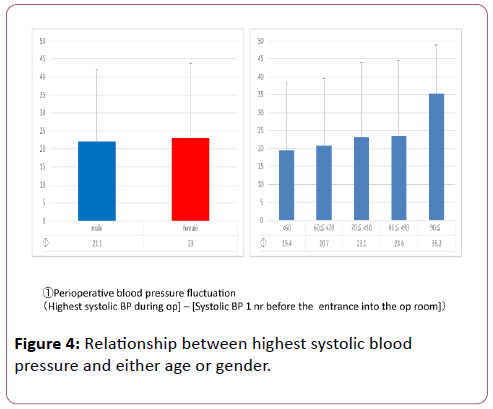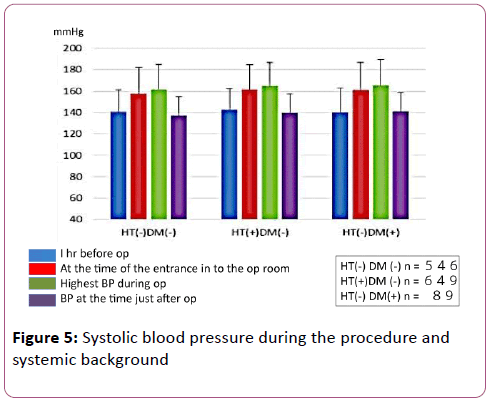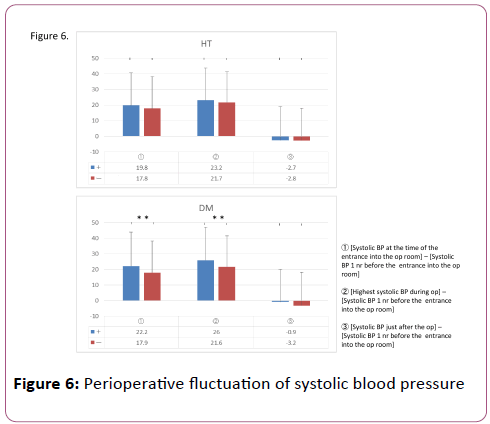Sai-ichi Tanaka*, Yuko Hayashi, Takayoshi Sumioka, Masahide Kokado, Nobuyuki Ishikawa, Takeshi Miyamoto and Shizuya Saika
Department of Ophthalmology, Wakayama Medical University School of Medicine, Kimiidera, Wakayama, Japan
- *Corresponding Author:
- Tanaka S
Department of Ophthalmology
Wakayama Medical University School of Medicine
Kimiidera, Wakayama, Japan
Tel: +81-73-447-2300
Fax: +81-73-448-1991
E-mail: s-tanaka@wakayama-med.ac.jp
Received date: August 28, 2017; Accepted date: September 05, 2017; Published date: September 08, 2017
Citation: Tanaka S, Hayashi Y, Sumioka T, Kokado M, Ishikawa N, et al. (2017) Influence of Underlying Diabetes Mellitus and Hypertension on Blood Pressure Alterations in Japanese Outpatient Cataract Surgery Patients. J Eye Cataract Surg 3:37. doi: 10.21767/2471-8300.100037
Copyright: © 2017 Tanaka S, et al. This is an open-access article distributed under the terms of the Creative Commons Attribution License, which permits unrestricted use, distribution, and reproduction in any medium, provided the original author and source are credited.
Keywords
Cataract surgery; Phacoemulsification; Hypertension; Diabetes; Oral antihypertensive drugs
Introduction
In a surgery performed under local anesthesia, mental stress before and during surgery can affect hemodynamics via the activation of the autonomic nervous system and other mechanisms. Compared with outpatient dental surgery, outpatient eye surgery is performed in a higher percentage of patients with systemic underlying diseases because, unlike surgery in young people, cataracts are age-related. It is said that approximately 40 million people in Japan have hypertension, which is equivalent to approximately one-third of the population. When examined by age, more than 50% of men and women in their 60s and more than 60% of men and women in their 70s receive treatment for hypertension [1]. Of the adult Japanese population, approximately 10.67 million have diabetes, and when examined by age, diabetes is present in approximately 3.55 million people aged 40–59 years and in 6.48 million people aged 60–79 years, revealing a noticeable age-related increase [2]. Diabetes can have a significant impact on general circulation because of its effects on the autonomic nervous system (diabetic neurosis) and vascular lesions, as typified by arteriosclerosis. Furthermore, a variety of intraoperative visual sensations that are specific to intraocular surgery may cause fear and stress in patients. Changes in hemodynamics before and during surgery have a negative effect on the cerebral circulation and cardiovascular system and can be a cause of systemic complications [3,4]. Therefore, a study on the relationship of blood pressure fluctuations on the day of cataract surgery and during surgery with underlying diseases (hypertension and diabetes) has deep significance [5-9].
In this study, we gathered data on fluctuations in blood pressure from the period before to the completion of surgery from the medical records of patients undergoing first-time outpatient cataract surgery at the Wakayama Medical University Hospital Department of Ophthalmology. We then used the data to retrospectively examine the relationship between fluctuations in blood pressure and the presence or absence of underlying hypertension or diabetes.
Subjects and Methods
The subjects were 1,529 patients (675 men and 854 women) who underwent first-time outpatient cataract surgery by phacoemulsification and aspiration with implantation of an intraocular lens under local anesthesia at the Wakayama Medical University Hospital Department of Ophthalmology between January 2013 and December 2014. The age of the patients ranged from 20 to 95 years (mean: 73.1 ± 9.8 years; Table 1).
| Numbers of patients |
Male (675); Female (854) |
| Age (years-old) |
73.1 ± 9.8; (range 20 - 95) |
| Operation time (min) |
90 ± 3.6 |
Table 1: Subjects included in the study
To differentiate the underlying diseases in this study, patients taking some kind of oral antihypertensive drugs were assigned to a “hypertension group,” while patients receiving some kind of medication for insulin-non-dependent diabetes were assigned to a “diabetes group.” The “hypertension group” comprised 891 patients, and the “diabetes group” comprised 336 patients (Table 2).
| Systemic complications |
Numbers (%) |
| Hypertension (HT) |
891 ÃÆÃâÃâïÃÆââ¬Å¡ÃâüÃÆââ¬Å¡Ãâ¹Ã¢â¬Â 58.3%ÃÆÃâÃâïÃÆââ¬Å¡ÃâüÃÆââ¬Å¡Ã¢ââ¬Ã° |
| Diabetes mellitus (DM) |
336 ÃÆÃâÃâïÃÆââ¬Å¡ÃâüÃÆââ¬Å¡Ãâ¹Ã¢â¬Â 22.0%ÃÆÃâÃâïÃÆââ¬Å¡ÃâüÃÆââ¬Å¡Ã¢ââ¬Ã° |
Table 2: Percentages of cases with hypertension or diabetes mellitus as defined in the manuscript
The cataract surgeries were performed under local anesthesia of either topical or sub-Tenon injection by several different surgeons and lasted for a mean duration of 9 ± 3.6 min. Blood pressure values 1 h before surgery, upon entering the operating room, and upon completion of surgery (removal of eyelid speculum) and peak intraoperative blood pressure were analyzed. During surgery, antibiotics were administered and an intravenous line was secured to control blood pressure in all patients. When elevated blood pressure was deemed to be the treatment target, blood pressure was normalized by administering intravenous nicardipine. Surgery did not need to be stopped because of a preoperative or intraoperative deterioration in the general condition of any of the patients. Statistical analysis was performed by using ANOVA. This study was approved by the institutional review board of the Wakayama Medical University Hospital.
Results
Changes in blood pressure during cataract surgery in all patients
Compared with the systolic blood pressure 1 h before surgery, it was significantly elevated upon entering the operating room and reached its peak. No significant differences were seen in the diastolic blood pressure throughout the course of surgery (Figure 1). On the basis of these blood pressure results, we proceeded to examine systolic blood pressure.
Figure 1: Mean systolic blood pressure in all subjects during surgery
Changes in systolic blood pressure by age
The numbers of patients in each age group was 122 in the >60 years group, 353 in the 60s group, 636 in the 70s group, 386 in the 80s group, and 32 in the 90s group. Significantly elevated blood pressure was seen upon entering the operating room, reaching its peak in each group. However, no significant differences were detected between the age groups (Figure 2).
Figure 2: Systolic blood pressure alteration in each patient age group
Systolic blood pressure by sex
The study included 675 men (mean age: 72.9 years) and 854 women (mean age: 73.3 years). Significantly elevated systolic blood pressure was seen in both men and women, as shown in Figure 3. However, no significant differences were seen between the sexes.
Figure 3: Gender and the alteration of systolic blood pressure during surgery
Influence of underlying conditions (diabetes, hypertension) on changes in systolic blood pressure
Table 3 shows the impact of the presence or absence of hypertension and diabetes on systolic blood pressure. Compared with the mean values of the systolic blood pressure of the entire patient sample, the systolic blood pressure of patients with underlying hypertension was higher before surgery, upon entering the operating room, during surgery, and after surgery (analysis of variance). In patients with underlying diabetes, systolic blood pressure was not higher than that of the entire patient sample 1 h before surgery but was significantly higher than that of the entire patient sample upon entering the operating room, during surgery, and upon completion of surgery (analysis of variance).
| |
Systolic blood pressure |
| 1 hr before op. |
At the time of the entrance into op room |
Intra-op |
Post-op |
| DM |
0.056 |
<0.001 |
<0.001 |
<0.001 |
| HT |
0.007 |
<0.001 |
0.001 |
0.004 |
Table 3: Analysis of variance of the relationship between systolic blood pressure and disease at the time of cataract surgery. Dark gray boxes: Statistically significant.
Relationship between the peak intraoperative systolic blood pressure, differences in preoperative blood pressure, and underlying diseases
Based on the above, we re-examined the peak systolic blood pressure 1 h before surgery and during surgery and changes in systolic blood pressure between these two points in time. The results of the examination of the difference between the peak intraoperative systolic blood pressure and preoperative blood pressure are presented in Table 4 and Figures 4-6.
Figure 4: Relationship between highest systolic blood pressure and either age or gender.
Figure 5: Systolic blood pressure during the procedure and systemic background
Figure 6: Perioperative fluctuation of systolic blood pressure
| |
Fluctuation of systolic blood pressure |
| ÃÆÃâÃââÃÆââ¬Å¡Ã¢ââ¬ÃÅÃÆââ¬Å¡Ãâà|
ÃÆÃâÃââÃÆââ¬Å¡Ã¢ââ¬ÃÅÃÆââ¬Å¡Ãâá |
ÃÆÃâÃââÃÆââ¬Å¡Ã¢ââ¬ÃÅÃÆââ¬Å¡Ãââ |
| DM |
0.001 |
0.001 |
0.073 |
| HT |
0.129 |
0.362 |
0.860 |
Table 4: statistical analysis of the perioperative fluctuation of the systolic Blood Pressure, Dark gray boxes: Statistically significant
As was found by the comparison of systolic blood pressure in the entire patient sample, changes in systolic blood pressure were also found to be significantly greater in patients with underlying diabetes. However, no significant changes were detected in patients with underlying hypertension.
Discussion
In this study, compared with systolic blood pressure 1 h before surgery, patients undergoing outpatient cataract surgery had statistically significantly elevated peak systolic blood pressure upon entering the operating room and during surgery. No significant changes were observed in diastolic blood pressure from 1 h before surgery up to the completion of surgery. Therefore, in this study, we examined changes in systolic blood pressure associated with surgery. Because cataract surgery is performed under local anesthesia, it appears that blood pressure rises with psychological stress [8-11].
To investigate the possibility that age-related changes in blood vessels influence systolic blood pressure, we divided patients aged <60 years and patients ≥ 90 years into groups for each decade to examine whether age affects surgery-related changes in systolic blood pressure. However, although systolic blood pressure upon entering the operating room and peak intraoperative systolic blood pressure differed significantly from systolic blood pressure 1 h before surgery within each age group, no significant results were seen between the groups. A comparison of the difference between peak systolic blood pressure 1 h before surgery and during surgery suggested that the values tended to increase with age in each age group. However, no statistically significant difference was detected. Next, we investigated the potential influence of male or female sex on systolic blood pressure. Elevated systolic blood pressure was seen in both men and women, as shown in Figure 3. There were no significant differences between the sexes. Furthermore, no statistically significant difference was detected between the sexes for the difference between peak systolic blood pressure 1 h before and during surgery.
Figure 6 shows the effects of patient background (hypertension and diabetes) on changes in systolic blood pressure. Of the entire patient sample, patients with hypertension had the highest systolic blood pressure before surgery, upon entering the operating room, during surgery, and after surgery (analysis of variance). In diabetic patients, systolic blood pressure 1 h before surgery did not differ significantly from that of the entire patient sample at the same time point. However, systolic blood pressure upon entering the operating room, during surgery, and upon completion of surgery was significantly higher in diabetic patients than that in the entire patient sample (analysis of variance).
We also investigated the relationship between underlying diseases and difference between peak intraoperative and preoperative systolic blood pressure (amount of change). Similar to the comparison of mean values for the systolic blood pressure of the entire patient sample, the difference between peak intraoperative and preoperative systolic blood pressure varied significantly more in patients with underlying diabetes than that in patients without diabetes, indicating a greater change in the diabetic group of patients. This trend was not detected in the patients divided into groups according to the presence or absence of hypertension. In the diabetic group of patients, blood pressure 1 h before surgery did not differ significantly from that of other patients, although the cause of the large elevation in blood pressure upon entering the operating room and during surgery remains unclear. However, the following factors are the potential causes of elevated blood pressure: increased circulating blood volume associated with hyperglycaemia, potential activation of the sympathetic nervous system associated with obesity and hyperglycemia, and facilitated activation of the renin–angiotensin system due to renal failure.
After outpatient cataract surgery, patients recover at home. Although some cases of cerebral or myocardial infarction are asymptomatic, both cerebral and myocardial infraction are associated with elevated blood pressure. Patients with hypertension had higher systolic blood pressure 1 h before surgery than the remainder of the patients, and this makes it easy to raise the awareness of hypertension among physicians and nurses. Meanwhile, patients with diabetes had more or less the same systolic blood pressure 1 h before surgery as the entire patient sample, i.e., they exhibited significantly elevated blood pressure in the operating room. It is therefore recommended to pay particular attention to changes in blood pressure associated with surgery and to fully explain the risks of elevated blood pressure prior to surgery to diabetic patients undergoing cataract surgery [12,13].
References
- IDF Diabetes Atras-7TH Edition 2015.
- Miura K, Nagai M, Ohkubo T (2013) Epidemiology of hypertension in Japan. Circ J 77: 2226-2231.
- Tan CS, Au Eong KG, Kumar CM (2005) Visual experiences during cataract surgery: what anaesthesia providers should know. Eur J Anaesthesiol 22: 413-419.
- Hogenson KD (1992) Acute postoperative hypertension in the hypertensive patient. J Post Anesth Nurs 7: 38-44.
- Tsuchihashi T, Takata Y, Kurokawa H, Miura K, Maruoka Y, et al. (1999) Blood pressure response during dental surgery. Hypertens Res 19: 189-94.
- Grossman E, Messerli FH (2008) Hypertension and diabetes. Adv Cardiol 45: 82-106.
- Sowers JR (2003) Recommendations for special populations: diabetes mellitus and the metabolic syndrome. Am J Hypertens 16: 41S-45S.
- Jandeleit-Dahm K, Cooper ME (2002) Hypertension and diabetes. Curr Opin Nephrol Hypertens 11: 221-228.
- Palatini P (2001) Sympathetic overactivity in hypertension: a risk factor for cardiovascular disease. Curr Hypertens Rep 3: S3-S9.
- Hsueh WA , Anderson PW (1993) Systemic hypertension and the renin-angiotensin system in diabetic vascular complications. Am J Cardiol 72: 14H-21H.
- Sowers JR, Epstein M, Frohlich ED (2001) Diabetes, hypertension, and cardiovascular disease: an update. Hypertension 37: 1053-1059.
- Suzuki R, Kuroki S, Fujiwara N, Umemoto S (1997) The effects of phacoemulsification cataract surgery via local anesthesia on preoperative and postoperative blood pressure levels. Ophthalmology 104: 216-222.
- Suzuki R, Kawata K, Kuroki S, Fujiwara N, Iwamoto M (1997) A comparison of blood pressure changes in phacoemulsification surgery with topical and retrobulbar block local anesthesia: part II. Ophthalmologica 211: 327-331.

